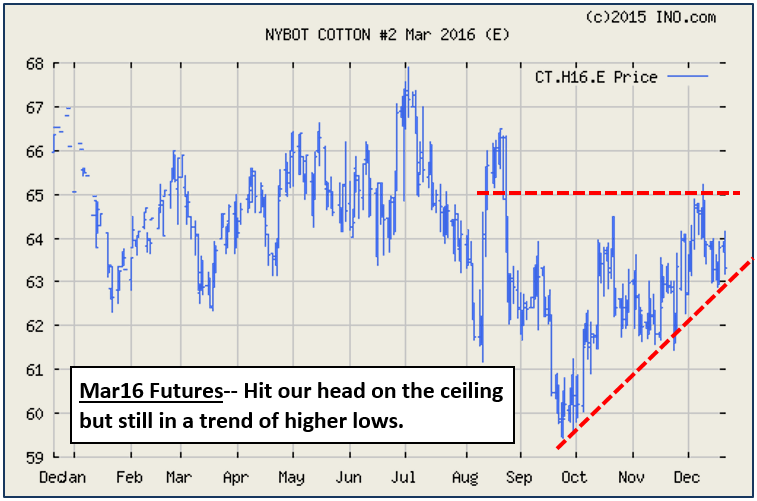 Don Shurley, University of Georgia Cotton Economist
Don Shurley, University of Georgia Cotton Economist
Prices. 2015 has certainly been a challenging year. But the marketing year is less than half over and there may yet be better opportunities down the road. Most growers were looking for and holding out for 70 cents on Dec15 futures, and we just never got there—close but never got the 7 in front.
Given the way the Marketing Loan and LDP works, waiting it out was a good strategy and most growers understand how and why this works. Additionally, it was expected that the cash/spot market would pay premiums for high quality, that contracting often does not. Given the likelihood of an LDP and quality premiums, downside risk was limited, and the opportunity cost of doing nothing was about 70 cents or even better anyway.
Looking ahead to the 2016 crop, a similar mindset will likely be needed. There are no guarantees that one marketing approach will work better than others—it’s all about a balance between price and risk management. Know the pros and cons, and evaluate your alternatives carefully. Prior to harvest, this typically includes Put Options, various types of contracting, or doing nothing. Growers may also wish to consider participating in a marketing association. With each alternative, it’s critical to know when you do and when you don’t have “beneficial interest” regarding receiving any LDP and also whether or not you will be rewarded for high quality fiber. Mar16 futures are currently around 63½ cents. Dec16 is between 64 and 65 cents. I have a sense that many growers have already taken the LDP and have either sold the crop, or nevertheless holding it in storage. Otherwise, the crop has gone to the Loan where the grower will redeem and receive any MLG or take a merchant equity.
Mar16 futures are currently around 63½ cents. Dec16 is between 64 and 65 cents. I have a sense that many growers have already taken the LDP and have either sold the crop, or nevertheless holding it in storage. Otherwise, the crop has gone to the Loan where the grower will redeem and receive any MLG or take a merchant equity.
At present, the outlook for 2016 is much the same as for the 2015 crop. With Dec16 again in the 60’s, this may not convince farmers to plant much cotton. But 2016 corn and soybean prices are not as attractive relative to cotton, as this year. Also, let’s not forget that at least ½ million acres intended for cotton in Texas was abandoned or switched to another crop, due to rain and delayed planting. Also, the large shift to peanuts in GA may not be repeated to that magnitude, due to crop rotation constraints.
There are no guarantees that a strong basis and quality premiums will hold for the 2016. Assuming they do and again, knowing the benefits of LDP’s—depending on weather, US cotton acreage and production could increase in 2016. This will place emphasis on demand growth for improved price direction.
Policy Adjustments. Several changes and/or possible changes, if approved, could act to improve the farm bill safety net for cotton in 2016. The recently passed Omnibus Appropriations bill requires USDA to begin allowing (reinstate) the use of commodity marketing certificates for Loan redemptions beginning with the 2015 crop marketing year. It is expected that this will be helpful to large and/or diversified producers facing payment limitations.
Efforts are also underway seeking that cottonseed be included as an “other oilseed” under the PLC and ARC provisions of the new farm bill. The mechanics how this would work and its impact for the grower are uncertain, but could be a big improvement in cotton’s safety net. The effectiveness and impact of this, if approved, will depend on (1) how base is determined, (2) what impact, if any, this will have on generic base, (3) what the PLC reference price will be, and (4) how any PLC or ARC payment will impact the already tight payment limitation for some growers.
STAX. Several modifications in STAX are forthcoming. In 2015, STAX had to be purchased for all cotton acres on a farm although a different coverage level (band) could be chosen for irrigated and non-irrigated production. For 2016, producers will be able to choose 0% coverage on either irrigated or non-irrigated (the policy will technically be a 70-70% policy). Farms with both irrigated and non-irrigated production will be able to essentially choose not to cover one or the other. Also new for 2016, there will be coverage for cottonseed. This will be a rider to the STAX policy. It is a yield only policy and will apply to the irrigated and non-irrigated acreage reported and the coverage bands chosen.
Don Shurley, University of Georgia
229-386-3512 / donshur@uga.edu
- Northwest Florida Beef Cattle Conference & Trade Show – February 11 - December 19, 2025
- Friday Feature:The Sears Catalog –How Rural America Shopped before the Internet - December 19, 2025
- November 2025 Weather Summary & Winter Outlook - December 5, 2025
